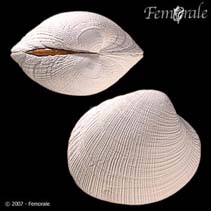Leukoma staminea (Conrad, 1837)
Pacific littleneck| Native range | All suitable habitat | Point map | Year 2050 |

|
| This map was computer-generated and has not yet been reviewed. |
| Leukoma staminea AquaMaps Data sources: GBIF OBIS |
Classification / Names Common names | Synonyms | CoL | ITIS | WoRMS
Bivalvia | Venerida | Veneridae
Environment: milieu / climate zone / depth range / distribution range Ecology
Benthic; depth range 0 - 46 m (Ref. 95344). Boreal, preferred 8°C (Ref. 107945); 60°N - 22°N, 166°E - 109°W
Distribution Countries | FAO areas | Ecosystems | Occurrences | Introductions
Pacific Ocean: West to east Bering Sea, Aleutian to Baja California.
Length at first maturity / Size / Weight / Age
Maturity: Lm ?, range 2 - 3.5 cm Max length : 7.5 cm SHL male/unsexed; (Ref. 95344); common length : 6.4 cm SHL male/unsexed; (Ref. 78182); max. reported age: 16 years (Ref. 104675)
Life cycle and mating behavior Maturity | Reproduction | Spawning | Eggs | Fecundity | Larvae
Main reference
References | Coordinator | Collaborators
Shaw, W.N. 1986 Species Profiles: Life Histories and Environmental Requirments of Coastal Fishes and Invertebrates (Pacific Southwest). Biological Report 82 (11.46) TR EL-82-4. (Ref. 78182)
IUCN Red List Status
(Ref. 130435: Version 2025-1)
CITES status (Ref. 108899)
CMS (Ref. 116361)
Threat to humans
Human uses
Fisheries: commercial
FAO - Aquaculture: production; Fisheries: landings | FishSource | Sea Around Us
Tools
More information
Max. ages / sizes
Length-weight rel.
Length-length rel.
Length-frequencies
Mass conversion
Abundance
Internet sources
BHL | BOLD Systems | CISTI | DiscoverLife | FAO(Fisheries: ; publication : search) | Fishipedia | GenBank (genome, nucleotide) | GloBI | Gomexsi | Google Books | Google Scholar | Google | PubMed | Tree of Life | Wikipedia (Go, Search) | Zoological Record



